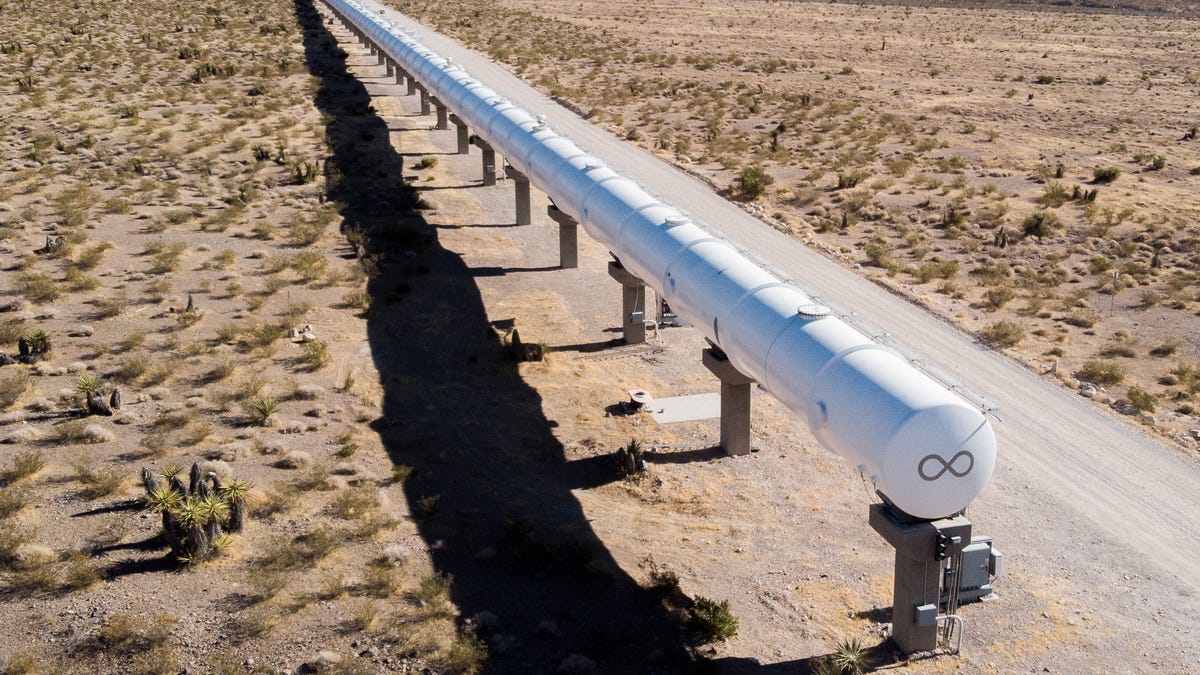Inside Virgin Hyperloop, I glimpse our high-speed transport future
Virgin Hyperloop promises a future with transport pods zooming through tubes at hundreds of miles per hour. To get there, it's built a prototype in a Nevada desert.

Virgin Hyperloop's Devloop prototype stretches across more than 500 yards in a Nevada desert.
It's not a call you expect to make on your way to Vegas: "I'm going to be in Nevada this week. Any chance I could get inside your futuristic, airless travel tube to take a look around?"
What sounded like the world's worst spec-fic pickup line was actually a last-minute request I put out to Virgin Hyperloop. The Richard Branson-backed company wants to shake up the future of transport by sending high-tech pods zooming through airless tubes at speeds of up to 670 miles an hour. To prove it's possible, Virgin has built a prototype "Devloop" tube in the Nevada desert, just outside Las Vegas, and I wanted to take a look. Others go to Vegas for the tables, I go for the tubes.
Until now, I'd been convinced that a hyperloop was just a pipe dream. But a few days after my Hail Mary call to Virgin, I was heading through the desert to Hyperloop headquarters. And when I arrived, I got a glimpse of the future (even if it feels very far off).
The Virgin Hyperloop builds on vision set out by Tesla, SpaceX and The Boring Company leader Elon Musk. In a white paper published in 2013, Musk described a vision for the Hyperloop Alpha, with high-tech pods zooming through tunnels at speeds of up to 760 miles an hour, on pockets of air (kind of like pucks on air hockey tables). Musk said the trip would feel like a ride on Space Mountain at Disneyland.
Though much of this vision has remained in Virgin's concept, the company has made some tweaks. Instead of traveling on pockets of air, Virgin's pods use a proprietary maglev (for "magnetic levitation") system to propel and guide the pods through the tubes. The result is a setup that Virgin says is more efficient than traditional maglev transport and will eventually offer airline speeds on the ground.
"The way we think about where we live, where we work, the way we think about distances will be very different," Virgin Hyperloop's director of test engineering, Samer Hamade, told me. "You look at the choices you have traveling from Los Angeles to Las Vegas. I can either drive my car, and I know it's going to take me anywhere between four to seven hours ... or I can just hop on a hyperloop and be there in 40 minutes. The choice becomes very apparent."
Out in the Nevada desert, I take a ride in a dune buggy up a long dirt road to see the very starting point for this transport future. A long white tube, stretching 500 meters (about 550 yards), through the rocks and sand.
This Devloop is just a fraction of what a completed hyperloop would be. But the bones are there. The huge door that seals off with a slam. The massive pumps that bring the tube down to a near vacuum over the space of three hours. The gate valve that lets passengers board via an airlock (no need to pump the air out of the whole loop every time). The smooth metal tracks that won't produce a screech and grind from wheels. And then there are the glowing neon lights stretching down the length of the hyperloop -- this is Virgin after all.
Virgin Hyperloop has a bold vision for the future of transport.
Stepping out of the 100-degree desert heat and into the cool air inside the tube, I get a sense of what could lie ahead. This loop is short, but it works. Virgin has completed multiple test runs in the Devloop, transporting its first human passengers in November 2020 and reaching a top speed of 107 mph.
Though it's early days, Virgin is banking on its hyperloop becoming the next big thing. It's talking up partnerships in India and Dubai, as well as support in the US (hyperloop technology was included in a recent infrastructure bill approved by the US Senate).
For my part, I can't tell if I'm standing in a prototype of the future, or just the physical manifestation of a back-of-the-napkin dream sketched out by an eccentric billionaire. After all, this is just one short loop. To get anywhere close to the scale Virgin envisions, the company will need a huge amount of investment and government support.
Still, if you'd told me 10 years ago that this kind of transport would be possible in my lifetime, and that I'd one day get to stand inside a working prototype, I wouldn't have believed you. Sometimes the future arrives sooner than we think.
To watch our visit to the Devloop and find out more about Virgin's vision for a hyperloop future, check out the video above.

